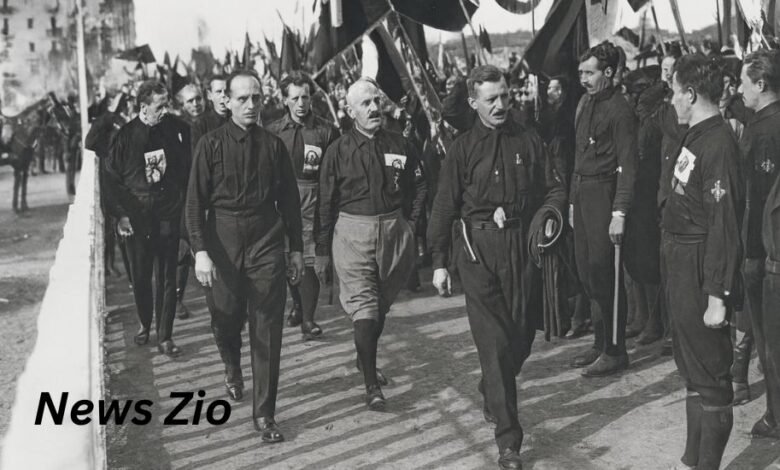Fascisterne: Denmark’s Fascist Legacy and Its Modern Meaning

The word fascisterne—Danish for “the fascists”—carries more than linguistic weight. It is a reminder of a turbulent chapter in European history, a cautionary term used in political debates today, and a linguistic artifact that reveals how societies remember their past. In Denmark, fascisterne points us directly to the interwar period, the rise of the Danmarks Nationalsocialistiske Arbejderparti (DNSAP), the country’s experience under German occupation, and the lingering memory of fascist ideology. Understanding the word’s evolution offers not only historical context but also insight into how Denmark, and Europe at large, confronts extremism in the 21st century.
The Word Itself: Language and Meaning
In Danish, fascisterne is simply the definite plural form of fascist—“the fascists.” On the surface, it functions grammatically like any other noun. But words are never only neutral containers. The definite article “-erne” turns the abstract into the concrete: not just “fascists” in general, but a specific, recognized group—the fascists.
The term has roots in the broader European phenomenon of fascism, an authoritarian ultranationalist ideology that emerged in Italy under Benito Mussolini in the early 20th century. Like other Scandinavian languages, Danish borrowed the word fascisme directly from Italian fascismo, itself derived from fasces, the bundle of rods symbolizing unity and authority in ancient Rome.
Thus, when Danes speak of fascisterne, they invoke not only local extremists but also a transnational ideology that shaped the continent’s darkest decades.
The Danish Fascist Party: DNSAP
The most prominent embodiment of fascisterne in Denmark was the DNSAP (Danmarks Nationalsocialistiske Arbejderparti), founded on November 16, 1930 by Cay Lembcke. Lembcke modeled the party on Hitler’s NSDAP, down to its uniforms and rhetoric. But it was Frits Clausen, who took over leadership in 1933, who gave the party its most recognizable form.
DNSAP’s program was explicitly national socialist—anti-communist, antisemitic, and ultranationalist. The party’s newspaper Fædrelandet spread propaganda, and its members marched in paramilitary style. During the 1930s, Clausen hoped to make DNSAP Denmark’s answer to Nazism in Germany.
However, DNSAP never achieved mass popularity. While Hitler’s NSDAP won millions of votes, DNSAP’s support peaked at around 20,000 members and modest electoral results. Danish political culture, rooted in parliamentarism and pragmatism, resisted fascism’s revolutionary call.
Fascisterne During the German Occupation (1940–45)
With Germany’s invasion of Denmark in April 1940, DNSAP saw an opportunity. Clausen and his supporters expected that Denmark might be reorganized as a fascist satellite state, and DNSAP positioned itself as collaborator-in-chief.
Although the Germans tolerated Clausen, they never granted him real power. Denmark’s monarchy and government retained more autonomy than many occupied countries, and DNSAP remained marginal. Even at the occupation’s height, fascisterne were often seen as opportunistic outliers rather than the rightful rulers of Denmark.
Still, the party’s collaboration, its propaganda, and its recruitment of Danes into German military units such as the Waffen-SS left deep scars. For many Danes, fascisterne became synonymous not only with an ideology but with betrayal of the nation.
Collapse and Marginalization After 1945
When the war ended, so too did DNSAP’s relevance. Clausen and other leaders were prosecuted, though Denmark’s legal system distinguished between high-level collaborators and ordinary members. The broader political culture had no appetite for fascism.
In the postwar decades, fascisterne survived only on the extreme fringes. Small neo-Nazi or ultra-right groups tried to keep the flame alive, but they were monitored by authorities and marginalized in elections. Unlike in Italy or Germany, where neo-fascist parties occasionally reached parliaments, Danish fascists never regained visibility.
The memory of occupation ensured that the word fascisterne carried a stigma—a marker of shame rather than pride.
Modern Far-Right Movements and the Term’s Use Today
Today, Denmark faces some of the same challenges as other European countries: debates about immigration, nationalism, and extremism. Yet when fascisterne is invoked in public discourse, it is often more rhetorical than descriptive.
Contemporary far-right parties in Denmark, such as the Danish People’s Party (Dansk Folkeparti), are nationalist but not openly fascist. Scholars and watchdog groups therefore distinguish between right-wing populism and outright fascism.
Still, extremist splinter groups with neo-Nazi leanings do exist, and researchers classify them under “højreekstremisme” (right-wing extremism). Institutions like the Danish Institute for International Studies (DIIS) monitor such movements, emphasizing the risk of radicalization even in small communities.
In online debates, activists and commentators sometimes use fascisterne broadly, applying it to opponents as an insult. This broadening of the term can dilute its historical specificity, but it also shows the enduring symbolic power of the word.
Comparative Perspective: Denmark and Its Neighbors
Placing fascisterne in a Scandinavian context clarifies Denmark’s distinct experience.
-
Norway had Vidkun Quisling, whose collaborationist regime became infamous.
-
Sweden maintained neutrality but had fascist currents on its fringes.
-
Finland cooperated with Nazi Germany against the Soviet Union but never developed a major homegrown fascist party.
In this spectrum, Denmark’s DNSAP was significant but never dominant. Its story illustrates how small democracies navigated the pressures of great-power fascism while maintaining political resilience.
Fascisterne in Memory Culture
In Denmark, memory of the occupation is central to national identity. Museums, school curricula, and public commemorations emphasize resistance, democracy, and sovereignty. Within this narrative, fascisterne appear as cautionary figures: the minority who chose collaboration and extremism.
Cultural memory often casts them as villains rather than political actors with serious prospects. This framing ensures that fascism is remembered as a warning, not a tradition.
Yet historians argue that this marginalization should not obscure the fact that fascisterne were real, organized, and actively sought to reshape Denmark. Remembering them accurately is essential to guarding against complacency.
Why Fascisterne Still Matter Today
Although DNSAP and its heirs are politically irrelevant, the term fascisterne endures in contemporary debates. It reminds Danes that extremism can arise even in stable democracies. It also warns against the careless use of history: labeling every opponent “fascist” risks trivializing the true danger fascism represented.
In a time when Europe again grapples with authoritarian movements and populist backlashes, reflecting on fascisterne helps ground public conversation. Denmark’s experience shows that while fascism can remain marginal, its shadow never fully disappears.
Conclusion
Fascisterne is more than a linguistic oddity. It is a window into Denmark’s interwar years, its wartime traumas, and its democratic resilience. To write about fascisterne is to grapple with both the dangers of extremism and the strength of democratic culture.
As history repeats in new forms, the story of Denmark’s fascists still matters—not because they won, but because they did not. Their failure is a reminder of what must be protected, while their existence is a reminder of what can resurface.
For more insights and deep-dives into history and politics, you can follow my blog News Zio, where we continue exploring the past to understand the present.



